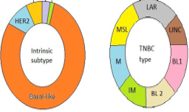Abstract
TNBCs or Triple negative breast cancers are characterized by the deficiency of progesterone and estrogen receptors and also the absence down regulation of Human epithelial growth receptor type 2 (HER2). TNBCs have low prognosis rate because of heterogeneity. The heterogeneous nature of this cancer has constrained the effective progress in drug targeting among certain people. In general HER2, PR and ER and the rate of proliferation are main predictive and prognostic factors in the detection of cancer of breast. Several pathways are involved in the progression of triple negative breast cancer from basal like cancer cells. The foremost being the loss by BRCA1-mediated pathway or mutation in the expression of several receptors. Certain groups have made some progress in unwinding TNBC's biological diversity and relating patterns of gene expression to molecular or genotypic subtypes. Earlier molecular categories of breast cancer use PAM50 via gene expression analysis to separate the breast cancer into the 4 intrinsic subtypes classified among many TNBCs in basal (BL) group and others divided between HER2 and luminal rich group. Currently, targeted therapy for TNBCs has not been approved. Nonetheless, there is continuous progress been made to detect the tumors at specific site for targeting and establish novel improved therapy. This review speaks about different approaches to TNBC treatment like cytotoxic therapy, targeted strategies, and chemotherapeutics by damage to DNA and targeting for repair of DNA and potent Nano carriers for targeting TNBC.
Full text article
Authors

This work is licensed under a Creative Commons Attribution-NonCommercial-NoDerivatives 4.0 International License.

